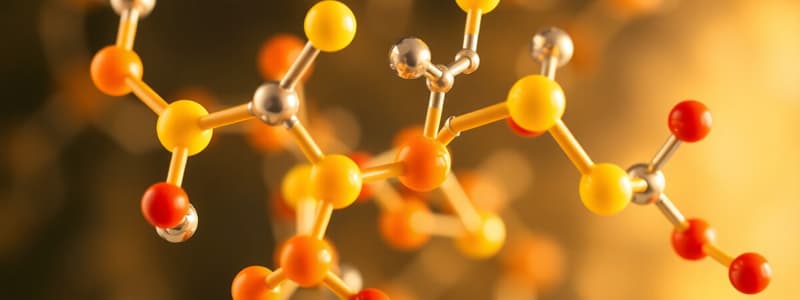Podcast
Questions and Answers
What is the primary function of the promoter in a plasmid?
What is the primary function of the promoter in a plasmid?
- Confers antibiotic resistance
- Contains many restriction enzyme sites
- Drives transcription of the gene of interest (correct)
- Allows plasmid replication
Competent bacteria can take up foreign DNA from their environment.
Competent bacteria can take up foreign DNA from their environment.
True (A)
What is the function of a multiple cloning site in a plasmid?
What is the function of a multiple cloning site in a plasmid?
It provides a region with multiple restriction enzyme sites for inserting DNA.
Calcium chloride (CaCl2) is commonly used to make bacteria competent by facilitating the uptake of ______.
Calcium chloride (CaCl2) is commonly used to make bacteria competent by facilitating the uptake of ______.
Which of the following methods creates pores in the bacterial membrane to facilitate DNA entry?
Which of the following methods creates pores in the bacterial membrane to facilitate DNA entry?
Match the following antibiotics with their use in plasmid selection:
Match the following antibiotics with their use in plasmid selection:
Screening is generally more efficient than selection in experimental procedures.
Screening is generally more efficient than selection in experimental procedures.
What temperature is used for heat shock during bacterial transformation?
What temperature is used for heat shock during bacterial transformation?
What is the main function of NaOH in the lysis buffer during plasmid isolation?
What is the main function of NaOH in the lysis buffer during plasmid isolation?
The desirable ratio for absorbance at 260 nm and 280 nm for DNA is approximately 2.0.
The desirable ratio for absorbance at 260 nm and 280 nm for DNA is approximately 2.0.
What is the purpose of using a silica column during plasmid isolation?
What is the purpose of using a silica column during plasmid isolation?
During neutralization, potassium acetate is used to lower the ______ and allow plasmid DNA to reanneal.
During neutralization, potassium acetate is used to lower the ______ and allow plasmid DNA to reanneal.
Match the following absorbance peaks with their respective substances:
Match the following absorbance peaks with their respective substances:
What is the purpose of the elution buffer in plasmid isolation?
What is the purpose of the elution buffer in plasmid isolation?
What is the formula to calculate the concentration of DNA?
What is the formula to calculate the concentration of DNA?
Resuspension buffer is used to precipitate unwanted components after the lysis stage.
Resuspension buffer is used to precipitate unwanted components after the lysis stage.
Which of the following is primarily used for measuring smaller volumes of liquid?
Which of the following is primarily used for measuring smaller volumes of liquid?
Animal cells have a cell wall.
Animal cells have a cell wall.
What is the purpose of transformation in bacterial genetics?
What is the purpose of transformation in bacterial genetics?
The formula for percent error is: (measured value - true value) / true value x _____
The formula for percent error is: (measured value - true value) / true value x _____
Match the following types of micropipettes to their measurement range:
Match the following types of micropipettes to their measurement range:
Which of the following is NOT a unit for measuring volume?
Which of the following is NOT a unit for measuring volume?
In transduction, genetic material is transferred via a bacteriophage.
In transduction, genetic material is transferred via a bacteriophage.
What is the standard deviation formula?
What is the standard deviation formula?
Flashcards
Plasmid
Plasmid
A circular, double-stranded DNA molecule independent of the chromosomal DNA. Often carries genes for survival, such as antibiotic resistance.
Origin of Replication
Origin of Replication
A specific DNA sequence on a plasmid that allows the plasmid to replicate.
Promoter
Promoter
A DNA sequence that initiates transcription of a gene.
Selection Gene (e.g., Antibiotic Resistance)
Selection Gene (e.g., Antibiotic Resistance)
Signup and view all the flashcards
Multiple Cloning Site
Multiple Cloning Site
Signup and view all the flashcards
Competent bacteria
Competent bacteria
Signup and view all the flashcards
Transformation methods
Transformation methods
Signup and view all the flashcards
Selection vs Screening
Selection vs Screening
Signup and view all the flashcards
Plasmid isolation
Plasmid isolation
Signup and view all the flashcards
Plasmid DNA
Plasmid DNA
Signup and view all the flashcards
Alkaline lysis
Alkaline lysis
Signup and view all the flashcards
Neutralization buffer
Neutralization buffer
Signup and view all the flashcards
260 nm absorbance
260 nm absorbance
Signup and view all the flashcards
280 nm absorbance
280 nm absorbance
Signup and view all the flashcards
A260/A280 ratio
A260/A280 ratio
Signup and view all the flashcards
Spectrophotometric analysis
Spectrophotometric analysis
Signup and view all the flashcards
Plant Cell vs Animal Cell
Plant Cell vs Animal Cell
Signup and view all the flashcards
Micropipette Types
Micropipette Types
Signup and view all the flashcards
Horizontal Gene Transfer
Horizontal Gene Transfer
Signup and view all the flashcards
Transformation (Genetics)
Transformation (Genetics)
Signup and view all the flashcards
Percent Error Formula
Percent Error Formula
Signup and view all the flashcards
Average Calculation
Average Calculation
Signup and view all the flashcards
Transduction (Genetics)
Transduction (Genetics)
Signup and view all the flashcards
Units of Volume
Units of Volume
Signup and view all the flashcards
Study Notes
Functional Groups
- Amine - NH₂
- Carboxylic acid - COOH
- Amide - CONH₂
- Hydroxyl - OH
- Aldehyde - CHO
- Ketone - CO-
- Ether - O-
Macromolecules
- Carbohydrates
- Types: Mono-, di-, oligo-, polysaccharides
- Monosaccharides examples: glucose (C₆H₁₂O₆)
- Disaccharides examples: sucrose
- Oligosaccharides, 3-10 monosaccharides; raffinose
- Polysaccharides examples: starch
- Polymerization: monosaccharides connected by glycosidic bonds
- Glycosidic bond types: alpha and beta
- Lipids
- Fatty acids: Saturated (no double bonds), unsaturated (double bonds)
- Cis: hydrogens on same side, trans: hydrogens on opposite sides
- Types: Glycerides (neutral, phosphoglycerides), steroids, waxes, phospholipids
- Bond: Ester bonds
- Phospholipids: hydrophobic tail, hydrophilic head (phosphate and fatty acid)
- Fatty acids: Saturated (no double bonds), unsaturated (double bonds)
- Proteins
- Monomeric unit: amino acids (20)
- Polymerization: amino acids connected by peptide bonds (dehydration)
- N-terminus: beginning; C-terminus: end
- Nucleic acids
- Monomeric unit: nucleotides
- Nucleotides composed of phosphate, sugar (deoxyribose in DNA, ribose in RNA), and base
- Purine bases (double rings): adenine (A), guanine (G)
- Pyrimidine bases (single rings): cytosine (C), thymine (T), uracil (U)
- Bond: Phosphodiester bonds
- 5' end: phosphate group; 3' end: hydroxyl group
- Types: DNA (deoxyribonucleic acid), RNA (ribonucleic acid)
- Monomeric unit: nucleotides
Genetics Lab Exam
- Gel electrophoresis: separates molecules (DNA, RNA, proteins) by size and charge using an electric field through a gel matrix (agarose or polyacrylamide).
- DNA/RNA detection: use methods like staining with dyes like ethidium bromide (EtBr), SYBR Safe, or GelRed, for visualization under UV or blue light.
- Plasmid isolation: process to isolate plasmids (extrachromosomal DNA) from bacterial cells, often using alkaline lysis for breaking open the cells.
- PCR (Polymerase Chain Reaction): method for exponentially amplifying a specific DNA sequence, requiring specific primers, dNTPs, DNA polymerase, and a thermal cycler.
- DNA extraction: process of isolating DNA from a sample via various methods.
Bacterial Transformation
- Horizontal gene transfer: transfer of genetic material between organisms not through parent-offspring transmission.
- Methods include: Transformation (uptake of free DNA), Transduction (DNA transfer via a vector), Conjugation (direct transfer via a pilus).
- Transformation: the uptake of free DNA by a competent bacterial cell.
Bacterial Transformation (continued)
-
Competent bacteria: cells capable of taking up extracellular DNA. A common technique to make bacteria competent is treatment with calcium chloride (CaCl₂).
-
Electroporation: uses brief electric pulses to create temporary pores in bacterial cell membranes, allowing DNA to enter.
- Heat shock: a different method to temporarily permeabilize the bacterial cell membrane, enabling the uptake of DNA
-
Selection vs. screening: Selection requires a successful transformation event to grow, whereas screening identifies transformed cells via a phenotypic marker.
-
Plasmid isolation: process of isolation plasmids (extrachromosomal DNA).
Spectrophotometry Analysis
- Wavelengths emphasize during the experiment: 260, 280, 230 nm.
- Nucleic acids absorbance: 260 nm
- Proteins absorbance: 280 nm
- Desirable Ratio: 260/280 (1.8 for DNA, 2.0 for RNA)
- DNA and 230 desirable ratio= 2.0-2.2
Restriction Digestion
- Restriction enzymes/endonucleases: enzymes that cut DNA at specific sequences (recognition sites)
- Palindromes: sequences that read the same forward on one strand and backward on the other strand
Population Genetics
- Genotype frequency: proportion of individuals with a specific genotype in a population
- Allele frequency: proportion of a specific allele in a population.
- Hardy-Weinberg equilibrium: theoretical model describing allele and genotype frequencies in a non-evolving population.
Mendelian Genetics
- Monohybrid cross: involves one trait and 3:1 phenotype ratio
- Dihybrid cross: involves two traits and 9:3:3:1 phenotype ratio
- Homozygotes: having two identical alleles for a gene.
- Heterozygotes: having two different alleles for a gene
- Dominant allele: allele that expresses its phenotype even in the presence of a recessive allele for a trait.
- Recessive allele: allele that only expresses its phenotype in the absence of a dominant allele for a trait.
Studying That Suits You
Use AI to generate personalized quizzes and flashcards to suit your learning preferences.



